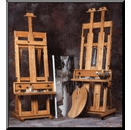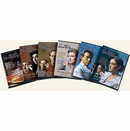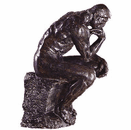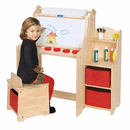Tips on Water color
Tips on Water color
Artists have enjoyed the charm of water colours for many centuries. Constable, Cotman and Cezanne used them to great effect. Beginners, too, can get excellent results after a little practice; the medium has a lot to offer. Please print these few pages and use them as helpful instruction.
The brightest white is the white of the paper itself. However, it will not be striking unless there are other not quite as bright parts to your work. There are many gradations of light.
Water colour paints are made from coloured pigment and gum arabic and are used by diluting them with water. (See the Factory Tour section) Depending on how much water you add, you can get pale, delicate colours or quite strong ones, to suit the different effects you are aiming at.
It is important not to overwork the painting, or you will lose that beautiful translucency that is essential to water colour. It is far better to spend time testing your colours on a piece of scrap paper before you start than to keep going over and over a painting in an attempt to improve the colour. The best water colour paintings have a look of freshness and spontaneity, so be bold.
For sketching your picture, an ordinary pencil will do; an HB or B will be fine. Remember that the pencil drawing will show through the transparent paint when you have finished. You could also try using NO pencil at all, which gives you a very soft, flowing effect. Brushes range in size from 00000, the smallest, to 14, which has a very large head. The thicker a brush is, the more paint it will hold at one go. So use a large brush for a wash and a small one for fine details. To keep a good point on your brush, smooth it back into shape with your fingers while it is still damp. Store your brush with the hairs pointing upwards.
Laying a wash
This is one of the basic water colour techniques, [It will give you an even 'wash', a liquid layer of diluted water colour over a larger area of paper; for example, in a sky]:
Have everything ready if you stop for any reason, you will get hard edges which you will not be able to erase. Mix up enough paint for the whole of the wash as you will not have time to mix any more when you have started. (To get an idea of how much you will need for the area you have to cover, you could practise with plain water on a spare piece of paper.)
Tilt the top end of the board your paper is resting on up a few degrees to make the diluted paint run towards you. Fill a brush with paint: for a very large area you would need a large brush. Drag the brush carefully along the top edge of the paper, noticing a bead of paint that will build up on the nearest edge.
Now reload the brush and repeat the action, overlapping the bead edge of the last brushstroke. Continue down the paper like this until you have covered the area. Clean up the last bead of paint at the bottom with the end of the brush.
There are many variations of the basic wash and it is worth experimenting. Try graduating a wash by adding more and more clear water as you go down the paper (as the sky fades towards the horizon); or blend colours together gradually or sharply to give interesting sky effects sunsets, clouds, water, mist...
Wet into wet
This very soft, flowing technique relies on the action of wet washes of paint on the paper. You will need heavy paper to be able to do it.
Either flow two washes into another on dry paper, or wet the paper with clear water first and then try adding colours. They blend beautifully perfect for skies, water, reflections, misty hills and so on.
Wax-resist technique
This technique gives a softer, fuzzier look than masking fluid. Use an ordinary candle to draw on your painting: when you come to paint on those areas you have waxed, the paint will run off. (This cannot be rubbed off as masking fluid can, and may discolour in the future.)
Scratching out
Working on good-quality paper gives you access to this technique, as it has the strength and thickness to stand up to it.
To add sparkle to a picture, try scratching the painted paper carefully with a sharp knife. This will take off the surface and give you little touches of pristine white paper. If you do this in horizontal strokes you will find it useful for points of light on water. It will also enliven a flat area, or correct a small mistake. Do not overuse this technique, and do not try to overpaint as the surface has been removed and will now behave differently from the rest of the paper.
Another way of removing colour you have already applied is wiping out or blotting. Try this for soft cloud effects. Simply blot a wet sky wash with a paper tissue to remove some of the colour.
You can also use this technique where a colour has turned out too strong: just wet the area with clean water and blot some of the colour off. It will not work so well where you have used a staining colour such as Viridian Hue.
Framing Your Work
Water colours need to be framed behind glass to protect them form dust and damp. Remember not to hang your paintings in bright sunlight, or you find that some colours will fade.
More on Watercolor
How to Choose Watercolor Paper (the following 4 tips were taken from an article by Tom Fong (published in the Artist's Magazine,) with the authors permission. The author is an artist and instructor living in Alhambra, California. He can be reached via e-mail at fongfam@juno.com):
1) A Tip For Beginners:
Practice and perfect laying washes down on cold-pressed paper before trying a more challenging surface. You'll get the most control and uniform responsiveness out of cold-pressed paper.
2) Rough Paper:
A textural effect is what you'll get when you paint on rough paper.
3) Advice to Experienced Artists:
As an artist you should learn to use all papers-and try a variety of brands. different papers vary in brightness and also in how they react. Try myriad techniques on different papers to get an idea of how the paper can help you achive your goals.
4) Hot Pressed Paper:
Hang onto your hat when you put a wash on hot-pressed paper-it's hard to control... I'd say it would be very suitable for two distinct kind of painters: 1) people who like to do fine drawing using a pen or a small brush working on dry paper, or 2) experimental painters who like to drop color on and tilt the paper, letting the paint reveal an image. I like to do abstracted flower images on hot-pressed paper.
A Palette of Plenty:
""Use more paint!" This lesson had a sudden, dramatic impact on my technique. In the past, the conservative dabs of paint on my palette complemented the "light touch" of my work. One evening during a watercolor class, my instructor, Connie Tucker, squeezed what seemed like an excessive gush of precious ultramarine blue onto my palette for a sky wash I was about to start for my landscape painting. The result? a stunning sky backdrop and a stunned student who immediately learned to use more paint for deeper colors and livelier paintings. Now I load my palette and brush with color so I paint with the intensity, power and contrast that create excitement and passion." Laura Scheper, Lexington, KY (The Artists Magazine, Feb. 04)
Let's end off with a wonderful note we saw from a watercolorist (Craig M. B., Las Cruces, NM) in Watercolor Magic Magazine: "Every year, I donate a few paintings to be hung in senior centers, public buildings... Not only does it feel good to use my talents for charitable purposes, I also gain exposure as an artist in the community. Plus at the end of the year, I can deduct the cost of the materials I used for these pieces on my income taxes."
The Flow factor by David Pyle, The Artist's Magazine, Sept. 2005
Is watercolor best suited to tight detail or loose, gestural, expressive application? The answer is yes to both water-color is versatile because of a phenomenon called hydrogen bonding. Without going all chemical on you, hydrogen bonding is why water forms into droplets when airborne. It's why belly flops hurt (your front side has to force apart many hydrogen bonds.) It's why snowflakes form in such breathtakingly beautiful crystals. And it's why there's such a variety in the ways in which watercolor can be applied, from dry brush to washy applications.
Artists have enjoyed the charm of water colours for many centuries. Constable, Cotman and Cezanne used them to great effect. Beginners, too, can get excellent results after a little practice; the medium has a lot to offer. Please print these few pages and use them as helpful instruction.
The brightest white is the white of the paper itself. However, it will not be striking unless there are other not quite as bright parts to your work. There are many gradations of light.
Water colour paints are made from coloured pigment and gum arabic and are used by diluting them with water. (See the Factory Tour section) Depending on how much water you add, you can get pale, delicate colours or quite strong ones, to suit the different effects you are aiming at.
It is important not to overwork the painting, or you will lose that beautiful translucency that is essential to water colour. It is far better to spend time testing your colours on a piece of scrap paper before you start than to keep going over and over a painting in an attempt to improve the colour. The best water colour paintings have a look of freshness and spontaneity, so be bold.
For sketching your picture, an ordinary pencil will do; an HB or B will be fine. Remember that the pencil drawing will show through the transparent paint when you have finished. You could also try using NO pencil at all, which gives you a very soft, flowing effect. Brushes range in size from 00000, the smallest, to 14, which has a very large head. The thicker a brush is, the more paint it will hold at one go. So use a large brush for a wash and a small one for fine details. To keep a good point on your brush, smooth it back into shape with your fingers while it is still damp. Store your brush with the hairs pointing upwards.
Laying a wash
This is one of the basic water colour techniques, [It will give you an even 'wash', a liquid layer of diluted water colour over a larger area of paper; for example, in a sky]:
Have everything ready if you stop for any reason, you will get hard edges which you will not be able to erase. Mix up enough paint for the whole of the wash as you will not have time to mix any more when you have started. (To get an idea of how much you will need for the area you have to cover, you could practise with plain water on a spare piece of paper.)
Tilt the top end of the board your paper is resting on up a few degrees to make the diluted paint run towards you. Fill a brush with paint: for a very large area you would need a large brush. Drag the brush carefully along the top edge of the paper, noticing a bead of paint that will build up on the nearest edge.
Now reload the brush and repeat the action, overlapping the bead edge of the last brushstroke. Continue down the paper like this until you have covered the area. Clean up the last bead of paint at the bottom with the end of the brush.
There are many variations of the basic wash and it is worth experimenting. Try graduating a wash by adding more and more clear water as you go down the paper (as the sky fades towards the horizon); or blend colours together gradually or sharply to give interesting sky effects sunsets, clouds, water, mist...
Wet into wet
This very soft, flowing technique relies on the action of wet washes of paint on the paper. You will need heavy paper to be able to do it.
Either flow two washes into another on dry paper, or wet the paper with clear water first and then try adding colours. They blend beautifully perfect for skies, water, reflections, misty hills and so on.
Wax-resist technique
This technique gives a softer, fuzzier look than masking fluid. Use an ordinary candle to draw on your painting: when you come to paint on those areas you have waxed, the paint will run off. (This cannot be rubbed off as masking fluid can, and may discolour in the future.)
Scratching out
Working on good-quality paper gives you access to this technique, as it has the strength and thickness to stand up to it.
To add sparkle to a picture, try scratching the painted paper carefully with a sharp knife. This will take off the surface and give you little touches of pristine white paper. If you do this in horizontal strokes you will find it useful for points of light on water. It will also enliven a flat area, or correct a small mistake. Do not overuse this technique, and do not try to overpaint as the surface has been removed and will now behave differently from the rest of the paper.
Another way of removing colour you have already applied is wiping out or blotting. Try this for soft cloud effects. Simply blot a wet sky wash with a paper tissue to remove some of the colour.
You can also use this technique where a colour has turned out too strong: just wet the area with clean water and blot some of the colour off. It will not work so well where you have used a staining colour such as Viridian Hue.
Framing Your Work
Water colours need to be framed behind glass to protect them form dust and damp. Remember not to hang your paintings in bright sunlight, or you find that some colours will fade.
More on Watercolor
How to Choose Watercolor Paper (the following 4 tips were taken from an article by Tom Fong (published in the Artist's Magazine,) with the authors permission. The author is an artist and instructor living in Alhambra, California. He can be reached via e-mail at fongfam@juno.com):
1) A Tip For Beginners:
Practice and perfect laying washes down on cold-pressed paper before trying a more challenging surface. You'll get the most control and uniform responsiveness out of cold-pressed paper.
2) Rough Paper:
A textural effect is what you'll get when you paint on rough paper.
3) Advice to Experienced Artists:
As an artist you should learn to use all papers-and try a variety of brands. different papers vary in brightness and also in how they react. Try myriad techniques on different papers to get an idea of how the paper can help you achive your goals.
4) Hot Pressed Paper:
Hang onto your hat when you put a wash on hot-pressed paper-it's hard to control... I'd say it would be very suitable for two distinct kind of painters: 1) people who like to do fine drawing using a pen or a small brush working on dry paper, or 2) experimental painters who like to drop color on and tilt the paper, letting the paint reveal an image. I like to do abstracted flower images on hot-pressed paper.
A Palette of Plenty:
""Use more paint!" This lesson had a sudden, dramatic impact on my technique. In the past, the conservative dabs of paint on my palette complemented the "light touch" of my work. One evening during a watercolor class, my instructor, Connie Tucker, squeezed what seemed like an excessive gush of precious ultramarine blue onto my palette for a sky wash I was about to start for my landscape painting. The result? a stunning sky backdrop and a stunned student who immediately learned to use more paint for deeper colors and livelier paintings. Now I load my palette and brush with color so I paint with the intensity, power and contrast that create excitement and passion." Laura Scheper, Lexington, KY (The Artists Magazine, Feb. 04)
Let's end off with a wonderful note we saw from a watercolorist (Craig M. B., Las Cruces, NM) in Watercolor Magic Magazine: "Every year, I donate a few paintings to be hung in senior centers, public buildings... Not only does it feel good to use my talents for charitable purposes, I also gain exposure as an artist in the community. Plus at the end of the year, I can deduct the cost of the materials I used for these pieces on my income taxes."
The Flow factor by David Pyle, The Artist's Magazine, Sept. 2005
Is watercolor best suited to tight detail or loose, gestural, expressive application? The answer is yes to both water-color is versatile because of a phenomenon called hydrogen bonding. Without going all chemical on you, hydrogen bonding is why water forms into droplets when airborne. It's why belly flops hurt (your front side has to force apart many hydrogen bonds.) It's why snowflakes form in such breathtakingly beautiful crystals. And it's why there's such a variety in the ways in which watercolor can be applied, from dry brush to washy applications.
Copyright © 2002-2025 Madison Art Shop™ LLC. All Rights Reserved.


















